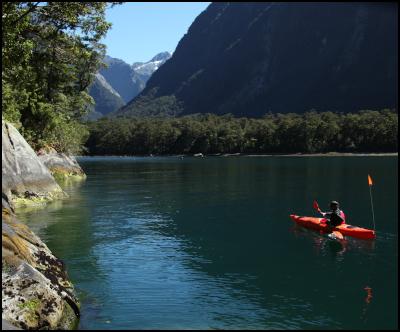Southern Discoveries to open kayak operation in Milford Sound

Premier New Zealand tourism
company Southern
Discoveries
Southern Discoveries will operate the kayak operation from the Milford Discovery Centre & Milford Deep underwater observatory, which the company has operated since 2006.
The new single-storey kayak facility will sit right alongside the observatory, joined by an elevated walkway. The kayak operation will sit on a new pontoon that features a hydraulic platform to lower and raise passengers into and out of the water in their kayaks.
The pontoon is in the same location as the base for a small tourist and scientific research submarine which ceased operation nine years ago.
Southern Discoveries General Manager John Robson said the kayak operation was planned to start in October this year in time for the busy summer season.
He said the aim was to provide a guided kayak activity in the calm, sheltered waters of Harrison's Cove as a great alternative to open water kayaking. A maximum of 12 passengers will be guided on up to four trips a day lasting about an hour-and-a-half. The total Milford experience will include a Southern Discoveries cruise, interactive visit to the Discovery Centre & Underwater Observatory, and kayaking experience.
"This is the perfect trip for people who want to have a short, gentle paddle," said Mr Robson. "Experienced kayakers and those with a relatively high degree of fitness are well catered for in Milford, but we'll be offering a slightly 'tamer' experience."
Mr Robson said it would be an estimated four-and-a-half-hours duration for the complete boat, observatory and kayak 'package'.
"The
full trip will be unrivalled in Piopiotahi Milford Sound in
giving visitors the most complete and knowledgeable
experience," he said. "I guarantee they'll leave as fervent
exponents of the natural values of the fiord and Fiordland
National
Park Mr
Robson said the Discovery Centre & Observatory fulfilled
Department of Conservation objectives of educating
international and domestic visitors about the necessity of
having World Heritage Areas with extremely limited access,
and the kayak facility would take that one step
further. "Empathy with the overwhelming landscape and this
wild and unpopulated valley will be greatly enhanced from
the perspective of a small kayak at a quiet 'water level'
experience," he said. "Coming as it does after a boat
cruise and a visit to the Discovery Centre, the kayak trip
will be the final link in the educative experience. "The
growth of kayaking is directly related to visitors wishing
to have a greater range of active experiences, as apposed to
the passive cruise experience, and their desire to feel as
though they are in the wilderness. "Many international
visitors, approximately 85% of all Milford visitors, have
never experienced such a pristine and rugged environment.
The kayaking operation will deliver this without impacting
on the environment in any way." Each trip will have a
designated guide, and groups will be divided into manageable
sizes. Inexperienced paddlers will be 'buddied up' with
either the guide or an experienced paddler. Mr Robson said
levels of 'average fitness' would be required. Trips will
not venture out into the main sound used by daily
sightseeing vessels. Mr Robson said the kayak guide would
be the final link in the interpretive chain, giving accurate
information on the rock formations, flora descriptions and
name of peaks within the Pembroke Valley and Harrison
Cove. Harrison Cove is a naturally sheltered bay with
Milford Sound that has provided shelter for vessels from
early whaling and sealing days from the 1800's to the
present. The mouth of the bay faces south and is open to the
fiord The northern beach end of the bay is bisected by the
Harrison River which runs down through the Pembroke Valley.
The western wall is the base of Williamson Point and eastern
is the Cascade range, both of which are typical of the steep
walls within Milford Sound, covered by indigenous bush and
scarred by tree avalanche
paths. ends



 Hugh Grant: How Can Telehealth And Home Healthcare Solutions Be Helpful?
Hugh Grant: How Can Telehealth And Home Healthcare Solutions Be Helpful? New Zealand Merino Company: The New Zealand Merino Company Will Investigate PETA Claims
New Zealand Merino Company: The New Zealand Merino Company Will Investigate PETA Claims New Zealand Certified Builders: Building A Granny Flat? Four Things You Should Know
New Zealand Certified Builders: Building A Granny Flat? Four Things You Should Know Paul Scofield & George Young, The Conversation: The Discovery Of A Rare New Fossil Sheds Light On NZ’s Extinct Dolphin-like Reptiles
Paul Scofield & George Young, The Conversation: The Discovery Of A Rare New Fossil Sheds Light On NZ’s Extinct Dolphin-like Reptiles Spirits New Zealand: A Year Of Two Halves For The NZ Spirits Industry
Spirits New Zealand: A Year Of Two Halves For The NZ Spirits Industry MoneyHub: Comprehensive Guide To New Zealand Wage And Salary Distributions
MoneyHub: Comprehensive Guide To New Zealand Wage And Salary Distributions



